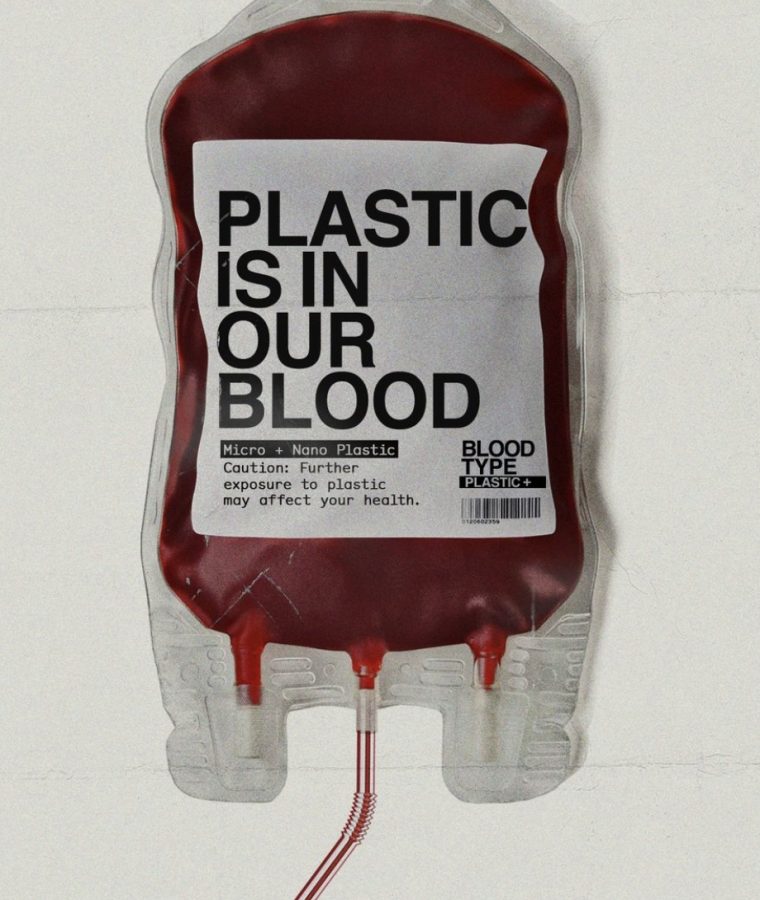There could be plastic in your blood, and the odds aren’t in your favor
A fake bag of blood with a scary, but true message—plastic can end up in our bloodstreams.
In the fourth grade, my class had a chance to tend a tank of salmon. When the salmon were old enough to be independent, we set them free in the Thornapple River. Periodically, an assigned group of students would test the water and feed them as they grew up, but in order to do that, my teacher curated a project for us all.
It was an informational video the groups had to make, and I was handed the responsibility of researching microbeads and their effects on different ecosystems. Throughout this project, I developed a passion for wildlife and our environment’s health. Recently, I discovered the script to my video segment deep in my Google Drive, scrolling past eras of my life and horribly assembled presentations.
In the script, I reported on microbeads–a form of microplastic–finding their way into a fish’s digestive system, and how it could create a chain of deaths. In addition, I emphasized how humans were at fault for this by using personal care products and how they could be impacted by microbeads.
In 2016, the how for a person’s impact was all hypothetical, but now in 2022, there is no longer a hypothesis to research, for the conclusion has already been proven true.
On March 24th, 2022, the Dutch National Organization for Health Research and Development (ZonMw) discovered microplastics in human blood. They tested blood from 22 anonymous donors with steel syringes and glass tubes to avoid any contamination. ZonMw found that almost 80% of the tests were positive for some type of microplastic.
They weren’t microbeads, however, but microplastics contaminating the donor’s blood that could be just as harmful. Microbeads are starting to appear less in our ecosystems, thanks to legislation passed in 29 states, but the causes for microplastics in bloodstreams are harder to combat.
It’s suspected that the most common transmission of microplastics into our blood is through plastic, unreusable water bottles, and the “clean” air in which we breathe daily. PET (polyethylene terephthalate) plastic, one of the seven forms of plastic, is only meant for a single-use. Therefore, it tends to break up into smaller particles quicker in ceratin circumstances than other plastics.
Right now, there is no definitive answer as to how microplastics are transmitted into the bloodstream or the health complications they can cause. Scientists are worried that microplastics can get stuck in organs and cause interminable health issues. Also, by using previous knowledge, PET plastic can leach (transfer harmful chemicals) to foods and drinks, typically caused by heating plastic or acidic food. Extensive periods without use can also promote leaching; for instance, a case of bottled water that has been sitting on stock shelves or pantries for a long time.
Think about what you’re being exposed to. Aside from the obvious preservatives and other additives, PET plastic has been proven to leach estrogen-like chemicals, enough to change our own hormonal system.
Sometimes, PET plastic can contain phthalates to add flexibility and longevity to it. Not every PET plastic product contains phthalates, but they are more likely to leach than the plastic itself. In typical room temperature and storage conditions, phthalates can leach, and it’s known to create an array of issues, spanning from infertility, type-2 diabetes, and even defects in newborns.
This is another chain reaction. Plastic is made from crude oil, and the oil industry is a scene of unethical actions and the tedious extractions are the root of some severe environmental impacts. The chemicals from factories that produce plastic are released through smoke and pollute our air and water, so the microplastic itself might not be the only cause for the transmission.
To thoroughly expel the chances of this problem means starting at square one for everyone. A change in lifestyle and ethics has to transpire, but in a world that revolves around greed and convenience, this is altogether improbable.
Today, with finite information about the effects of microplastics, all we can do is adapt to a cleaner version of our everyday lives and establish moderate consumption habits before the plastic changes ours, but as fourth-grade Sydney would say, “Those are just some simple ways micro[plastics] can be very affecting for you and the poor little salmon.”

For a third round, Sydney returns to write for The Central Trend as a junior. During the summer, she attended the Washington Journalism and Media Conference...



























































































